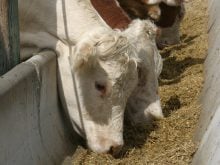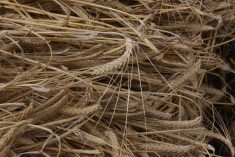Producers ‘almost doing cartwheels’ | American calf crop shrinks to the smallest in 60 years
Records are being broken across the Prairies as feeder cattle sell for prices that are up 75 percent from a year earlier.
A combination of the lower Canadian dollar, lower feed prices and lower overall cattle numbers has sent calf prices skyward.
“It seems like everything has gone right for the cattle industry this year,” said Brian Perillat, senior market analyst for Canfax.
Young 550-pound steers born in spring are selling for $3 per pound compared to $1.60 a year ago.
“It’s phenomenal,” said Perillat, who points to a series of changes that created the strong market.
Read Also

Pakistan reopens its doors to Canadian canola
Pakistan reopens its doors to Canadian canola after a three-year hiatus.
Most significant is Canada’s link to the U.S. market.
American cattle numbers continue to shrink with the smallest calf crop in 60 years, while drought has dried up traditional cattle producing areas and cheap American corn is creating ideal cattle feeding conditions.
“A lot of feeder cattle are going straight to Nebraska,” said Perillat.
“It’s more fun selling than buying them,” he said.
It was a good day for cattle producer Brad Corbiell of Cluny, Alta., who sold his Hereford cattle Oct. 21 at Balog Auction in Lethbridge.
“It’s really promising to have such strong prices. Hopefully, some of these ranchers can get back on their feet and some younger guys will think, ‘you know, this is pretty good,’ ” he said.
“We’ve got to take it when we can get it. As a producer, it’s a little bit spooky in a way because never in history have we had this high a price before. I guess we’re all optimists, but you’ve got to wonder how long it’s going to last. Hopefully, a long time.”
Brian Good, director of field services for the Canadian Angus Association, said 2014 has been a remarkable year for calf prices.
It’s not unheard of for a 700-lb. calf born in the spring to bring almost $1,900, up $700 to $800 from last year.
Producers are “in awe,” said Good, who travels across Alberta to cattle sales, talking to producers and promoting Angus.
“They’ve never been this high before. Talking to some of the old timers and they’re plumb excited,” he said.
“They’re almost doing cartwheels down the street when they leave the auction mart.… It’s just one of those darn good years. I’ve never seen anything like it.”
Brent Weiss, an owner and auctioneer at Cowtown Livestock Exchange in Maple Creek, Sask., said cattle producers are “unbelievably happy” with this fall’s prices.
Producers can’t help but smile when they pick up the cheque after selling their calves.
Weiss said one stern-looking rancher picked up his cheque with his typical grim expression and walked out of the office, but returned soon after.
“He said, ‘there’s a problem with the cheque.…’ He said, ‘it’s about twice as much as I expected.’ ”
Weiss said the rancher then smiled.
“I have never, ever seen prices like this.”
The Oct. 23 sale at Maple Creek, Sask., with 3,950 head brought in slightly more than $5.5 million, but two other sales that week had equally strong prices.
Black steers weighing 550 lb. were sold for $2.85 to $2.99 per lb. Another group of black 600 lb. steers sold for $2.71 to $2.75 per lb.
“Prices are very, very strong,” said Weiss.
Despite the strong prices, there is little talk from producers who previously sold their herds wanting to get back into the business.
Weiss said some producers are holding back good heifers for replacements, but not all of their heifers.
“There might be a few more calves being kept back because they have more money in their jeans.”
John Williamson, manager of the Mankota Stockmen’s Weigh Co., said 400 to 500 lb. steers recently sold for $3.70 a lb. at a Black Angus pre-sort sale.
Another group of 1,353 steers sold for $3.25 per lb.
“They were an exceptional group of Black Angus cattle,” said Williamson.
About 1,000 head went to a local feedlot, but the rest scattered in every direction.
Williamson said there have been herd dispersals because of the high prices, but more importantly he hopes some producers will expand their herds or be enticed to get back into the cattle business.
“It gets tough to hold that heifer back when you’re getting $1,400 for her.”
Williamson believes markets will be strong for a number of years unless there is another outbreak like the BSE crisis of 2003, which sent markets tumbling.
“If you were in it, it was pretty tough sledding for a while,” he said.
“It’s a gut feeling that it’s going to be strong for a few years. Everybody is happy. It’s a good environment to be in. It makes paying the bills a lot easier.”
Dyce Bolduc of Stavely, Alta., recently hosted a satellite sale of 2,500 calves born from bulls originating from his herd but now owned by different customers.
Prices were $2.90 to $3 per lb., which equates to about $600 to $700 per head more than what was received a year ago.
“It’s a little like having a third more cows,” said Bolduc.
“The guys were really happy.”
Bolduc doesn’t expect the Canadian cow herd to grow just yet.
“Cows are a 365 day a year commitment. Getting back into the cow business is not easy.”
It’s a sentiment shared by Bob Prestage, a cattle exporter from Camrose.
“A lot of producers destroyed most of their fences when they sold the cows, they were so down in the dumps. I don’t see any changes in the next three to five years. There is still some apprehension,” he said.
“The problem we have is there is too much gray hair sitting around the tables.”
High prices have their own issues.
More money rolling through the auction market forced Weiss to secure a larger line of credit to ensure there was enough money in the bank when all the buyers and sellers deposit and draw money.
Perillat said cattle buyers’ normal line of credit no longer stretches as far.
“It’s hard sourcing enough capital to fill out a feedlot,” he said.














